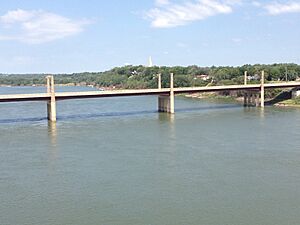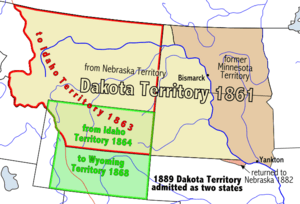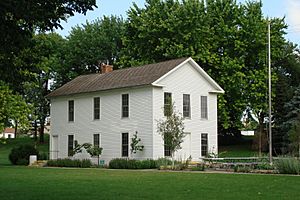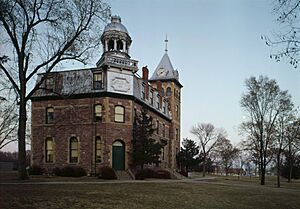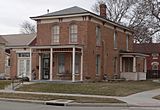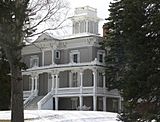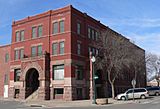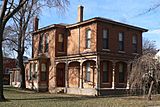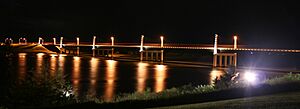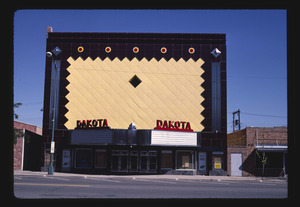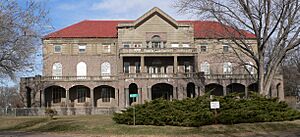Yankton, South Dakota facts for kids
Quick facts for kids
Yankton, South Dakota
|
|
|---|---|
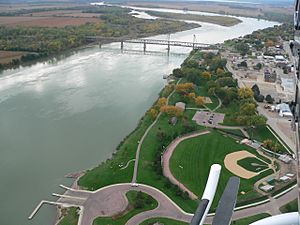
|
|
| Nickname(s):
"Mother City of the Dakotas"
|
|
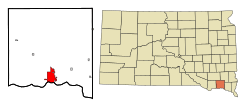
Location in Yankton County and the state of South Dakota
|
|
| Country | United States |
| State | South Dakota |
| County | Yankton |
| Incorporated | 1869 |
| Government | |
| • Type | Council-Manager |
| Area | |
| • City | 8.91 sq mi (23.08 km2) |
| • Land | 8.67 sq mi (22.45 km2) |
| • Water | 0.24 sq mi (0.62 km2) |
| Elevation | 1,243 ft (379 m) |
| Population
(2020)
|
|
| • City | 15,411 |
| • Density | 1,777.51/sq mi (686.31/km2) |
| • Metro | 23,297 (US: 485th) |
| Time zone | UTC−6 (CST) |
| • Summer (DST) | UTC−5 (CDT) |
| ZIP codes |
57078-57079
|
| Area code(s) | 605 |
| FIPS code | 46-73060 |
| GNIS feature ID | 1267665 |
Yankton is a city in South Dakota, United States. It is the main city of Yankton County and became a city in 1889.
In 2020, about 15,411 people lived there. This made it the 7th largest city in South Dakota. Yankton is also the main city of the Yankton Micropolitan Statistical Area, which had about 23,297 people in 2021.
Yankton was the first capital of Dakota Territory. Its name comes from the Yankton tribe of Western Dakota people. The word I-hank-ton-wan in the Dakota means "the end village."
The city is located on the Missouri River. It is just below the Gavins Point Dam and Lewis and Clark Lake. The National Park Service has its main office for the Missouri National Recreational River in Yankton. The Human Services Center, a hospital for mental health, was started here in 1882. It is now on the National Register of Historic Places.
People often call Yankton the "River City." This is because it is close to the Missouri River. The river was very important for the city's early growth. Yankton is also known as the "Mother City of the Dakotas." This is because it played a big role in forming the Dakota Territory. This territory later became North and South Dakota.
Yankton also used to be called "Cement City." This was because it produced cement from Fort Hays Limestone. Some of this cement was even sent to help build the Panama Canal.
Contents
Where is Yankton Located?
Yankton is in southern South Dakota, right on the border with Nebraska. It sits on a special part of the Missouri River. This part of the river is one of the last natural, free-flowing sections. The U.S. National Park Service has named it the Missouri National Recreational River. This area stretches from Gavins Point Dam, west of Yankton, to Ponca State Park in Nebraska.
The city's main downtown area is on a natural landing along the Missouri River. To the west, the land rises to a high bluff called "Mount Marty." The Marne Creek also flows through the city and into the Missouri River.
The United States Census Bureau says Yankton covers about 8.45 square miles (21.9 square kilometers). Most of this is land, with a small part being water.
What is Yankton's Climate Like?
Yankton has a humid continental climate. This means it has cold winters and hot summers.
| Climate data for Yankton 2 E, South Dakota (1991−2020 normals, extremes 1932−present) | |||||||||||||
|---|---|---|---|---|---|---|---|---|---|---|---|---|---|
| Month | Jan | Feb | Mar | Apr | May | Jun | Jul | Aug | Sep | Oct | Nov | Dec | Year |
| Record high °F (°C) | 74 (23) |
78 (26) |
93 (34) |
95 (35) |
107 (42) |
110 (43) |
116 (47) |
112 (44) |
105 (41) |
96 (36) |
83 (28) |
70 (21) |
116 (47) |
| Mean maximum °F (°C) | 54.2 (12.3) |
59.6 (15.3) |
74.1 (23.4) |
84.8 (29.3) |
90.9 (32.7) |
96.8 (36.0) |
98.0 (36.7) |
96.6 (35.9) |
92.8 (33.8) |
85.8 (29.9) |
71.6 (22.0) |
55.4 (13.0) |
100.1 (37.8) |
| Mean daily maximum °F (°C) | 30.0 (−1.1) |
34.9 (1.6) |
47.1 (8.4) |
60.0 (15.6) |
71.9 (22.2) |
82.4 (28.0) |
87.1 (30.6) |
84.8 (29.3) |
77.5 (25.3) |
63.3 (17.4) |
47.2 (8.4) |
34.0 (1.1) |
60.0 (15.6) |
| Daily mean °F (°C) | 20.2 (−6.6) |
24.6 (−4.1) |
35.9 (2.2) |
47.7 (8.7) |
59.8 (15.4) |
70.7 (21.5) |
75.4 (24.1) |
73.1 (22.8) |
64.8 (18.2) |
50.9 (10.5) |
36.2 (2.3) |
24.5 (−4.2) |
48.7 (9.3) |
| Mean daily minimum °F (°C) | 10.4 (−12.0) |
14.2 (−9.9) |
24.6 (−4.1) |
35.4 (1.9) |
47.7 (8.7) |
58.9 (14.9) |
63.8 (17.7) |
61.5 (16.4) |
52.1 (11.2) |
38.5 (3.6) |
25.3 (−3.7) |
14.9 (−9.5) |
37.3 (2.9) |
| Mean minimum °F (°C) | −12.7 (−24.8) |
−7.1 (−21.7) |
2.8 (−16.2) |
20.5 (−6.4) |
33.7 (0.9) |
47.1 (8.4) |
51.8 (11.0) |
50.0 (10.0) |
35.7 (2.1) |
21.7 (−5.7) |
6.7 (−14.1) |
−6.9 (−21.6) |
−16.7 (−27.1) |
| Record low °F (°C) | −29 (−34) |
−28 (−33) |
−25 (−32) |
2 (−17) |
24 (−4) |
33 (1) |
41 (5) |
35 (2) |
23 (−5) |
12 (−11) |
−15 (−26) |
−31 (−35) |
−31 (−35) |
| Average precipitation inches (mm) | 0.65 (17) |
0.91 (23) |
1.60 (41) |
3.36 (85) |
3.68 (93) |
4.03 (102) |
3.46 (88) |
3.26 (83) |
2.85 (72) |
2.56 (65) |
1.27 (32) |
1.03 (26) |
28.66 (728) |
| Average snowfall inches (cm) | 6.7 (17) |
8.5 (22) |
4.7 (12) |
3.7 (9.4) |
0.2 (0.51) |
0.0 (0.0) |
0.0 (0.0) |
0.0 (0.0) |
0.0 (0.0) |
0.8 (2.0) |
5.9 (15) |
7.6 (19) |
38.1 (97) |
| Average precipitation days (≥ 0.01 in) | 4.8 | 5.3 | 6.3 | 8.8 | 11.6 | 10.6 | 8.0 | 8.5 | 7.3 | 6.9 | 4.8 | 5.2 | 88.1 |
| Average snowy days (≥ 0.1 in) | 3.3 | 3.6 | 2.4 | 1.2 | 0.1 | 0.0 | 0.0 | 0.0 | 0.0 | 0.5 | 1.6 | 3.8 | 16.5 |
| Source: NOAA | |||||||||||||
Who Lives in Yankton?
| Historical population | |||
|---|---|---|---|
| Census | Pop. | %± | |
| 1880 | 3,431 | — | |
| 1890 | 3,670 | 7.0% | |
| 1900 | 4,125 | 12.4% | |
| 1910 | 3,787 | −8.2% | |
| 1920 | 5,024 | 32.7% | |
| 1930 | 6,072 | 20.9% | |
| 1940 | 6,798 | 12.0% | |
| 1950 | 7,709 | 13.4% | |
| 1960 | 9,279 | 20.4% | |
| 1970 | 11,919 | 28.5% | |
| 1980 | 12,011 | 0.8% | |
| 1990 | 12,703 | 5.8% | |
| 2000 | 13,528 | 6.5% | |
| 2010 | 14,454 | 6.8% | |
| 2020 | 15,411 | 6.6% | |
| 2021 (est.) | 15,483 | 7.1% | |
| U.S. Decennial Census 2020 Census |
|||
In 2010, there were 14,454 people living in Yankton. There were 5,909 households and 3,348 families. The city had about 1,760 people per square mile.
Most people in Yankton (92.1%) were White. Other groups included African American (2.1%), Native American (2.3%), and Asian (0.7%). About 3.4% of the population was Hispanic or Latino.
About 27.3% of households had children under 18. The average age in the city was 40.4 years. About 20.9% of residents were under 18, and 17.9% were 65 or older.
A Look at Yankton's History
Early Inhabitants and Explorers
Before European settlers arrived, the Yankton Sioux (Nakota) lived where Yankton is now. In 1804, the Lewis and Clark explorers visited the area. They met with the Yankton Sioux Tribe at a place now called Calumet Bluff.
In 1857, a Yankton Sioux village led by Chief Pa-le-ne-a-pa-pe ("Struck by the Ree") was at the city's current site. Two years later, the Yankton Treaty of 1858 opened the land for new settlers. The city started where a small creek, now called Marne Creek, flowed into the Missouri River. Yankton grew as a stop for steamboats. They would pick up fresh water and supplies, especially after gold was found in the Black Hills.
Yankton as Dakota Territory Capital
On March 2, 1861, President James Buchanan signed a law creating Dakota Territory. Yankton was chosen as the capital. President Abraham Lincoln then appointed William A. Jayne as the first governor. The first capitol building was a simple wooden structure. It was located at Fourth and Capitol Streets. The original building is gone, but a copy of it stands in Yankton's Riverside Park. Yankton was the capital until 1883, when it moved to Bismarck.
The Yankton Stockade
In 1862, there was a conflict in western Minnesota. Governor Jayne asked all men aged 18 to 50 in eastern Dakota to form groups to protect against possible attacks. In Yankton, a large stockade (a fort made of strong posts) was built. Settlers from nearby areas came to Yankton for safety. Although some groups of Native Americans came near Yankton, no attack happened. The stockade was later taken down. A monument now marks where it once stood.
Yankton College: A Place of Learning
In 1881, a group decided to start "Pilgrim College" in Yankton. This was to be the first private college in Dakota Territory. When it officially started, its name was changed to "Yankton College." Classes began in 1882. Yankton College was an important part of the city for over 100 years. However, it closed in 1983 due to money problems. The historic campus, which is on the National Register of Historic Places, was later bought by the Federal Bureau of Prisons. It is now a minimum-security prison called the Federal Prison Camp – Yankton.
River Port and the Great Flood of 1881
Yankton was a great place for steamboats to stop along the Missouri River. The first steamboat from St. Louis arrived in 1859. It brought goods and supplies to settlers and fur traders. The city grew even more after gold was found in the Black Hills in 1874. By 1880, Yankton was a busy riverboat port.
But on March 27, 1881, a huge ice jam on the Missouri River broke. Floodwaters and giant blocks of ice rushed towards the town. By March 29, the riverfront and downtown were covered in water, ice, and rocks. Several riverboats were destroyed. This flood, along with the growth of railroads, caused Yankton's riverboat traffic to slow down. The railroad had already reached Yankton in 1872. Over the next few years, Yankton's role as a major stop on the way west became less important.
In 1882, the Human Services Center was established as a hospital for mental health. On June 2, 1883, the capital of Dakota Territory was moved from Yankton to Bismarck.
Historic Places in Yankton
Yankton has a rich history, and you can see it in its buildings. There are 26 individual buildings and 6 historic areas in the city listed on the National Register of Historic Places. This list is kept by the U.S. National Park Service. Each historic area has many important buildings. Some of these areas include:
- the Yankton (residential) Historic District
- the Yankton College Historic District
- the Yankton High School Historic District
- the Yankton Historic Commercial District
- the House of Gurney Historic District
- the South Dakota Human Services Center campus
Education in Yankton
Yankton has several schools. The Yankton Public School District serves students from kindergarten through 12th grade. There is also Sacred Heart Catholic School for younger students.
Mount Marty University is a private Catholic university in Yankton. It was founded in 1922 as Mount Marty College Academy. It became a four-year college in 1951 and a university in 2020. Its sports teams are called the Lancers.
Yankton High School has many activities, including sports and clubs. The boys' teams are called the Yankton Bucks, and the girls' teams are the Yankton Gazelles. The high school also hosts a debate tournament each January.
Fun and Recreation
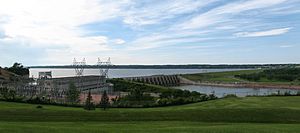
Yankton has 14 city parks. Fantle Memorial Park has an outdoor swimming pool. Riverside Park has a baseball field. There are two golf courses: Fox Run (public) and Hillcrest Golf and Country Club (private). The city and school district also share the Yankton High School and Summit Activities Center. This center has an indoor pool, gyms, and a weight room.
The old Meridian Bridge over the Missouri River used to carry cars. In 2008, a new bridge, the Discovery Highway Bridge, opened. The old Meridian Bridge was then turned into a pedestrian bridge. It is now part of the city's walking and biking trails. The Brokaw-Auld Trail is another path along Marne Creek. The State of South Dakota has also built trails near the Lewis and Clark Recreation Area.
Just four miles west of Yankton is Lewis and Clark Lake. Over 1.5 million people visit it each year. The Lewis and Clark State Recreation Area offers camping, swimming, hiking, biking, and boating. The Lewis and Clark Resort and Marina is also there, with cabins, boat slips, and a restaurant. The U.S. Army Corps of Engineers also has public recreation areas along the Missouri River below Gavins Point Dam.
Getting Around Yankton
Yankton has its own airport, the Chan Gurney Municipal Airport. However, for commercial flights, you would go to Sioux Falls Regional Airport or Sioux Gateway Airport in Sioux City, Iowa.
U.S. Route 81 runs north and south through Yankton. It connects the city to Nebraska across the Missouri River using the Discovery Bridge. This bridge replaced the older Meridian Highway Bridge in 2008. Interstate 90 is about 65 miles north, and Interstate 80 is about 160 miles south via U.S. Route 81.
South Dakota Highway 50 goes east and west. It connects Yankton to Interstate 29, which is about 33 miles to the east. South Dakota Highway 52 connects the city to the Lewis and Clark Lake area, about four miles west.
Media and News
Broadcasting in Yankton began in 1922 with WNAX radio. Today, Yankton has several radio stations:
AM Radio Stations
- 570 WNAX: Talk radio
- 1450 KYNT: Soft adult contemporary music
- 1570 KVTK: ESPN Radio (sports)
FM Radio Stations
- 89.7 KUSD: Public radio/NPR
- 93.1 KKYA: Country music
- 94.3 KDAM: Hot adult contemporary music
- 104.1 WNAX-FM: Country music
- 106.3 KVHT: Classic hits
There are no commercial TV stations based in Yankton. TV stations from Sioux Falls and Sioux City serve the area.
Yankton is also home to South Dakota Magazine. This magazine comes out every two months and covers the history, culture, arts, travel, and outdoors of the state. It is published in a historic building from 1875.
Culture and Arts
Mount Marty University offers many cultural experiences in Yankton. The Bede Art Gallery shows art from local and Native American artists. Marian Auditorium hosts plays and art events. The university also brings famous writers to campus for readings and workshops.
Yankton is home to the Dakota Territorial Museum. It is in the restored Mead Cultural Education Building. The museum has information and items about Yankton's history, Native American groups, and early settlers. The museum also has old buildings like a schoolhouse and a train depot.
Yankton's Riverboat Days is a big yearly festival in August. It attracts many visitors and features over 150 artists and 50 food vendors at Riverside Park. Other activities include a rodeo, a parade, and a golf tournament.
Sports in Yankton
The National Field Archery Association (NFAA) has its main office in Yankton.
Special Sporting Events
The NFAA's Easton Yankton Archery Complex has hosted big events. In 2015, nearly 600 archers from 51 countries came for the World Archery Youth Championships.
Yankton in Pop Culture
Games
- Yankton is a Native American settlement in the video game Empire: Total War.
- One of the made-up U.S. states in the game Grand Theft Auto V (2013) is called North Yankton. It's named after the city and county.
Television
- Yankton is mentioned many times in the TV series Deadwood.
- Yankton is mentioned in The Middle episode, "Hecks on a Train" (2015).
Famous People from Yankton
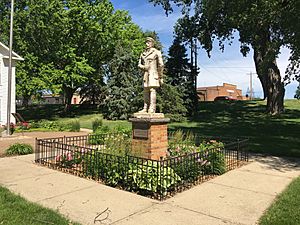
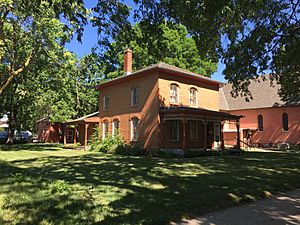
- Lyle Alzado: NFL player who played college football at Yankton College.
- General William H. H. Beadle: Surveyor General of Dakota Territory and an educator.
- Tom Brokaw: Former NBC news anchor, graduated from Yankton High School.
- John Chandler "Chan" Gurney: Served as a United States Senator from South Dakota.
- Colton Iverson: Basketball player for the NBA Boston Celtics.
- William A. Jayne: First governor of Dakota Territory.
- Grant Marsh: A famous steamboat captain on the Missouri River.
- Adam Vinatieri: A well-known NFL placekicker, born in Yankton.
- Joseph Ward: An educator and founder of Yankton College.
- Lawrence Welk: A famous bandleader who lived in Yankton.
- Chief Pa-le-ne-a-pa-pe: A leader of the Yankton Sioux Tribe.
Images for kids
See also
 In Spanish: Yankton para niños
In Spanish: Yankton para niños


